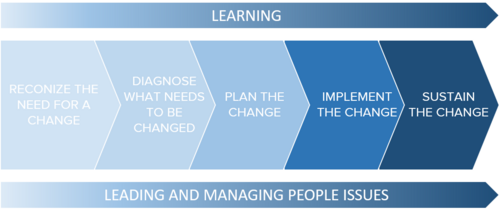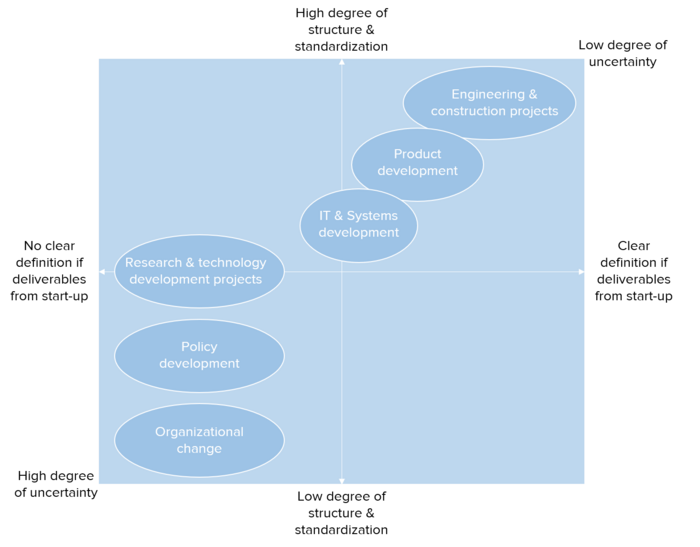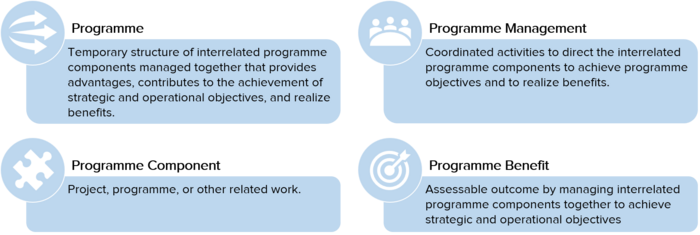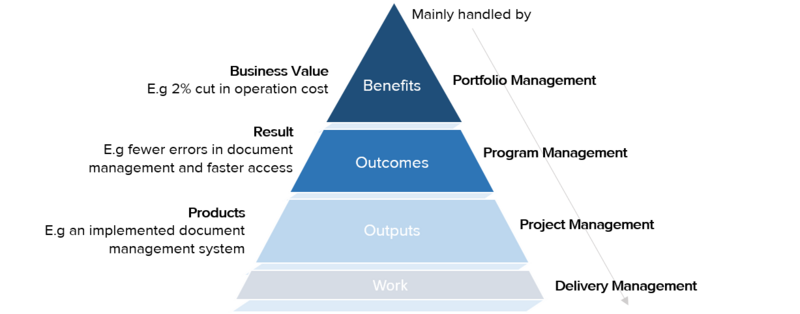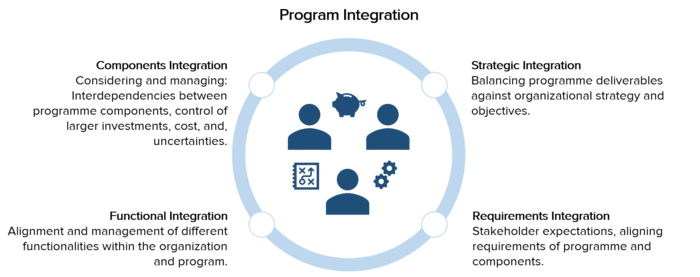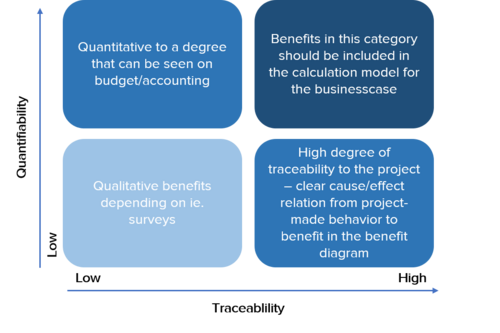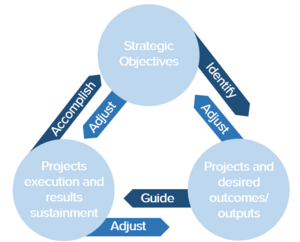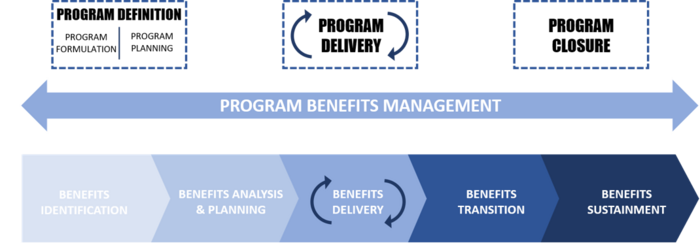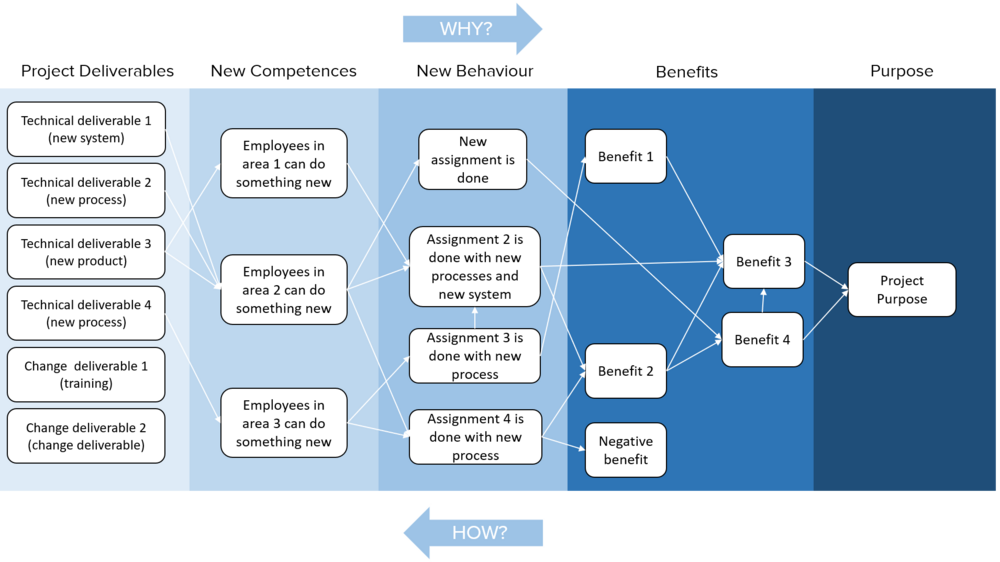Benefit Mapping in Change Programs
Contents |
Abstract
In order to stay competitive, organizations must recognize and act upon the fact that they need to change and adapt to changing environments and fast-moving markets [1].
When a company is going through a change process, the desired direction is steered by the company strategy that is defined by the senior management [2]. The strategy and priorities are the ground for the portfolio that have a purpose to achieve a number of benefits that will put the company in a preferably position in the future [3]. This article focuses on benefits related to organizational change, meaning changes where the purpose is to transform how the company is functioning in order to be more efficient, effective or both. These benefits can be achieved by executing a change program, which consist of a number of program components that have the purpose to enable the desired organizational change when combined.
No matter what level of change a company strives for, it will demand people changing the way they work [4]. thus, a change in human behavior. This makes it highly important for an organization to understand the different levels of impact of the change being initiated, so it can be translated and communicated to all relevant stakeholders, in a way that ensures a successful implementation [5]. However, “a general view states that up to 60 percent of change programs fail to achieve the targeted outcomes” [6] this indicates, that organizations lack the capability of driving the change successfully. A way to drive change, that has been proven to increase the success rate, is to use the methodology of Benefit Realization which focuses on the connection between purpose and deliverables, and proposes multiple layers between the two, that must be considered in order to ensure executing the right actions [7]. The overview of the entire connection is gained by using the method benefit mapping, which creates paths from purpose to benefits through five different steps as seen on figure 1.
The aim of this article is to provide the reader with a general understanding of change management and program management. In addition, it will give the reader the acquired knowledge to discuss the overall theory behind benefit realisation and give an insight to the general practice of using the tool benefit map.
Change Programs
The Project Management Institute states that “Organizations employs program management to improve their abilities to deliver benefits.”[8]. In addition they suggest that in commercial organizations, these benefits would most often relate to business value which can both be tangible such as financial KPI’s and non-tangible such as brand recognition [8]. There are many ways to achieve desired benefits, which creates the ground for different types of programs, one of them being organizational change programs [9]. A change program focuses on optimizing functionality of the organization and should have the purpose to “realize benefits, which are aligned to strategic and operational objectives, that may not be realized when components are managed individually. The program may also improve efficiency, reduce threats and realize opportunities” [10]. Concrete examples are:
- Agile transformation (going from working waterfall to agile)
- Merging with another company
- Going from silo to matrix organization
- Splitting up functions into smaller units
- Large Cost Cutting/ Restructuring
All of the above have in common, that the goal is to realize a certain benefit, and that to succeed, the organization must change how they work. Thus, the result of the program depends deeply on the program managements capability to ensure that the future way of working realizes the benefit thereby aligning the operation of the company with the strategy. In this section, the context of Change Management and Program Management are established, in addition some challenges of succeeding with change programs are investigated.
Change Management
As stated earlier, an organization must change in order to survive, and thus, every company must be able to manage change. The general change management process can be divided into five main phases that must be completed in order to succeed with the change, while also having a focus on learning plus leading and managing people issues, this can be seen on figure 2:
Figure 2: The Change Management Process (redrawn from [11])
Within each step there are a number of theories and practices that can be used in order to succeed with the individual step [12], these both contain management of soft issues here meant as the culture and change willingness of the people involved and the hard issues understood as the capabilities of executing new behavior. However, even with a large theoretical toolbox within change management, the degree of uncertainty is considered very high. According to Ollson and Attrup [13] a project concerning organizational change, is the project type with highest uncertainty due to two factors: Lack of clear definition of deliverables from start-up and low degree of structure and standardization, the scale can be seen at figure 3. As change programs consists of change projects and components, it is assumed that the logic can be used on programs as well.
Figure 3: Project types in relation to uncertainty (redrawn from [14])
The factor concerning structure and standardization indicates, that change projects and programs lack a formal organization and cannot use standards within project execution. The other factor concerning how specific the project/program is, states that within change projects/programs it is highly difficult to define and predict which deliverables the projects will produce [14].
The decision of what needs to be done and whether the change should be executed through a single project, or if the complexity and/or size demands multiple aligned projects, thus a program [15], is made in the beginning of phase three - plan the change, and will rely directly of the discoveries in the diagnosis phase [12]. If it is revealed that program level is suitable, the organization should initiate this program, and perform program management, which is described in the following.
Program Management
To understand the fundamentals of programs and program management the ISO standard for Guidance in Program Management [10] suggests four definitions which will be used in this article. These are seen on figure 4:
Figure 4: Definitions of program terminology (information from: [10])
Looking at the organizational context of program management, Prince2 states that it is the link between the outputs seen as products from projects and benefits being the business value within one or more strategic goals, that the cumulative delivery of products leads [16] [17]. Thus, making the Program Management responsible for translating desired benefits into project objectives and managing an ongoing amount of projects into delivering the results needed to realize the benefits. This is illustrated on figure 5.
Figure 5: Relation between Output, Outcome, and Benefit (redrawn from [17])
Taking a closer look at the program management organization it should, according to ISO 21503, consist of three main roles each taking a specific responsibility [10] :
- Program Sponsor: “Responsible for the overall programme strategy and advocacy of the programme” [10]
- Program Manager: “Responsible for the overall performance of the programme and coordinating the programme components” [10]
- Program Management Team: “Responsible for the performance and implementation of one or more programme components or functions.” the team could consist of: The program sponsor, program manager, change manager, program component manager and administrative support [10]
These are the main persons responsible for the initiation and execution of the program. When initiating a program, the ISO 21503 suggest that the program management:
- Make a framework, that enhances the performance of the program, by establishing responsibilities and accountabilities, and facilitating support functions and providing the right amount of resources [10].
- Develop a programme design and plan, that plan and identify elements of the program. Examples on elements are: interdependencies of components, program roadmap, and stakeholder management strategy. [10].
The initiating work lays the foundation for the entire program, and it is crucial that this is done properly. However, it is also important to know, that during the lifecycle of the program, changes should create value. In relation to programs change management “is proactive and adaptive to focus program on an evolving understanding of benefits, capabilities and environment” [9].
As a program consists of many components, involves a lot of stakeholders throughout the organization, it is often a complex process, and it is crucial that the program management are able to integrate different elements of the program. On figure 6, it is seen what areas should be involved in program integration.
Figure 6: Program Integration (information from [10])
In order to ensure continuous integration, the areas above should be managed throughout the program existence, however, it is important to have a exhaustive overview before the execution of the program begins, this will be discussed in the last part of this article.
When execution a program, general practices across program components should be established. Examples of areas such practices may cover are: Risk and Issue Management, Quality Management and, Schedule Management . When approaching finalization a formal closure procedure is needed. This should verify and archive different elements of the program components. It also include the verification that the program benefits have been realized or transferred [10].
There exists many possible factors that can affect the success of the program. However, based on information provided in this section two main causes can be identified:
- The program deliverables are not completed
- The program deliverables does not trigger the desired benefit
The next part of the article will have its focus on benefit realization, the part of program management that focuses on ensuring and maintaining the link between deliverables and desired benefit, thus minimize the risk of failing due to the second main cause.
Benefit Realization
The realization of benefits is a central part of every program, and benefit management is also mentioned as an independent element in the ISO 5305 (12) and the PMI Standard for Program Management (7). Project Management Institute’s pulse of the profession In-depth report on benefits (14), states that “Organizations with high BRM (Benefit Realization Management) maturity see an average of 50% more projects meeting original goals and business intent” (14). This is based on answers from over one thousand project management professionals in various industries, indicating that using the methodology enhances the success rate significant. Thus, it is considered highly important for an organization to be able to apply a process to enhance the chance of realizing the desired benefits.
Benefits
A benefit can be defined as “gains and assets realized by the organization and other stakeholders as the result of outcomes delivered by the program” [18]. As stated earlier benefits can both be tangible and intangible, in addition it was concluded that change programs was uncertain partly due to the fact, that it is difficult to identify what should be delivered in order to create the right change, thus realize desired benefits. Rytter et. al. agree with these points [19]. They suggests that benefits should be estimated in order to evaluate them in relation to the business case [20]. Thus, benefits should be divided into 4 categories depending on their traceability and quantifiability. This is illustrated on figure 7:
Figure 7: Categories for identified benefits (redrawn from [20])
It should be noted that identified benefits that are not in the high/high category should still be managed and realized, however, the overview provides the insights that there exists different types of benefits within a program or project, and creates a ground for considering different approaches to the management of different benefits throughout the whole benefit realization process that is explained in the following.
The Benefit Realization Process
PMI Thought Leader Series suggests that “BRM helps maximize project, program, and portfolio value by incorporating and articulating accountabilities across stakeholders to identify, execute, and sustain strategic outcomes.” (16 p.3). Thus, incorporating a BRM process should increase an organization’s ability to link the strategy with program components and project deliverables. PMI states that the Strategy helps identify desired outcomes and outputs that guides the project execution used to accomplishes the strategic objectives. At the same time, the elements has a reverse effect adjusting each other, as the process progresses. An overview and illustration of the link between these are shown on figure 8:
Figure 8: Relations between: Strategy, Outputs and outcomes, and project execution (redrawn from [21])
The connection between the elements shown on figure 8, is triggered through a BRM process. The PMI standard for program management suggest a process consisting of five phases. These can be seen on figure 9.
Figure 9: The Benefit Realization process (redrawn from [22])
As illustrated benefit management is executed from the program is initiated and until the program closure, the ISO 21503 suggests that it should begin when the project is in consideration, and increase the detail level, as the program is established [23].
Within each step of the process the Program Management Team has different assignments to accomplish or delegate. To do this, different tools and sub-processes are developed [24]. This article will not go into further detail with the different phases, but focus on one important tool within BRM. This tool is called Benefit Mapping, the next section will explain the use of the tool in practice.
Benefit Map
A benefit map is a visual overview of identified benefits and their connection concrete deliverables. There exists different versions of the tool, Gojko Adzic suggests the following elements should be present: “Strategic Objective”, “Benefits”, “Business Change”, and “Enabler” [25]. Rytter, Lind and Svejvig propose a version with five elements: “Purpose”, “Benefits”, “New behaviour”, “New Competences”, and “Project deliverables” [26]. There is a clear resemblance between the two mentioned versions and they both have the objective of increasing the insights from the why to the how of the program or project [25] [26]. Thus, the tool focuses on one of the factors making a change program highly uncertain presented previously (fig. 3) and can be used to decrease or address program uncertainty. This article will use the version proposed by Rytter et. al. presented in the book Benefit Realization: Create more value in your projects [26]. The model is seen at figure 10:
Figure 10: Benefit Map (redrawn from [27])
Zooming in on benefits, it is seen that the area is larger than the others, do to the fact that it is suggested to divide benefits into two categories “Performance Benefits” ie. 10% less complaints and “End Benefits” ie. reduced staffing resulting in a yearly cost reduction of 200.000 [28]. It is also seen that negative benefits are also addressed, this should also be considered on a high level scale, and could include for example loss in performance [28]
The Tool
As stated, the benefit map is a way to approach the break down of a project or program purpose into concrete components or deliverables. To increase the chance of success, the tool forces deep considerations into the linkage, by addressing the mechanism that lies between. Overall the benefit map is said to (list [29]):
- Give an overview of the benefits
- Show how benefits are created
- Indicate the size of the change assignment
- Be a communication tool that explains the “why”
- Is used for the control of scope
Looking closer at the model, it is seen that it directly mentions the change in behaviour that is demanded to achieve desired benefits, this makes it highly relevant to use in auspices of Change Management, as implementation of new behaviour is, as stated earlier, a crucial success criteria within this field. Rytter et.al. suggests that training of employees in new processes, tools, systems etc. is done in order to establish new competences, thus a link between “deliverables” and “competences”, and that change management practices are in focus when the new competencies are becoming new behaviour [30].
The benefit map is considered very beneficial to use in relation to change programs [31], as it makes it clear what is needed, how it is achieved and why it should be done.
The Tool in Practice
The benefit map can be used for multiple purposes and is often not created in one go [26] Taking a standing point in change programs, the practice of how to use a benefit map is explained in the following. Its usage is divided into three main categories: Program Establishment, Communication, and Program Control. Based on the nature of the map, it should ultimately be owned by the program sponsor, however the facilitation can be delegated to a member of the steering-group (program management team) [32].
Program Establishment
In the program establishment, the program management are responsible for identifying the desired benefits, and create an overall plan on how to achieve these. The first version of the map is created by having a workshop with the program management and key stakeholders. Starting from Purpose, and then going from right to left, breaking down one element at the time and placing findings on the map, thereby, creating a complete overview of the program. This can be used directly in the making of the first version program plan, and address the program integration, through the discussion of each connection. [32]. In addition it is used to define ownership and delegate responsibilities, which as stated is an important part of creating the program framework [10]. This process helps decreasing the uncertainty of a change program as it qualifies and define the program components based on a very thorough examination of their direct impact.
Communication
When the benefit map is created, it can be used as a central part of the communication strategy throughout the organization. Program managers who has a deep insight should explain the content to project managers. Here, it should also be considered to delegate concrete responsibilities, that can be managed by project managers, in order to ensure the right amount of empowerment, thus, motivation [33] The explanation of concrete behavior should, according to Münster, ensure a high chance of people changing their behavior, as it is transparent and easy for the brain to know how to do what and why it should be done, leading a decrease in resistance. Thus, the benefit map can be used to decrease the number of people issues through the change process [34].
Program Control
Throughout a program life-cycle change should be implemented accordingly [9]. The benefit map is here used in order to ensure that the changes does not result in a scope creep but are aligned with the program purpose, by adding/removing elements to the map and draw the new connection with the new knowledge. Thus, the benefit map can be used to incorporate and analyze learning through the change process. In addition, it can be used to monitor if the different program components are delivering as expected and if not, the chain can be investigated in order to identify why a part of the program is not performing [32]. Thus, it can help in the process of adjusting the elements in figure 8. The program management team should continuously revisit and evaluate on the benefit map, at pre-planned scheduled meetings, the frequence should be determined by the complexity and uncertainty of the program.
Limitations
As stated, the benefit map is considered a great tool, however, it also has limitations. First of all, the benefit map can quickly be too complex, if the detail level becomes too high. If this happens, it is difficult to maneuver in the map and get the desired overview. Another challenge is the fact that a benefit map is an additional tool to a comprehensive process, and too many tools, . If one or more of the program management team members does not see the value of the tool, it can quickly create resistance towards the tool, not using it properly, thus, not getting the desired value. Last, it can be a very large assignment to administrate the benefit map throughout the program, making sure it is updated with the latest agreements etc. If the map is not updated continuously, it quickly loses its value, as it will not represent the current execution of the program, thus, it is important to consider this in resource planning and establishment of program management team.
Suggested Reading
Change Management
- John Hayes: The Theory and Practice of Change Management
This book explains the change management process from start to finish, and consider challenges within the field such as people issue and implementation of learning. It is used for educational purpose in the course: Change Management in Engineering Systems at the Technical University of Denmark.
- Henriette Divert and Michael Kræmmer: Change & Effect: Five Principles for Implementing real Organizational Change
This book gives insights in best practice implementation of change with a standing point in practical application. It has a focus on change leadership and consider practical experience from the last decades.
- Morten Münster: Jytte fra Marketing er desværre gået for i dag (behavioral change)
This book puts a great focus on the practice and theories of behavioral design. It refers to a number of experiments that explains how the human mind reacts in relation to the perception of change, and suggests how to use that knowledge to design and implement organizational changes.
Program Management
- DS ISO: 21503
This standard created by the International Standard Organization gives a quick overview of the content and elements to program management
- PMI: Program Management: The Standard of Program Management
This standard created by the Project Management Institute, provides a thorough examination of program management.
- John Ryding Ollson and Mette Lindegaard Attrup: Power in Projects Portfolios
This book highlights the succesful Scandinavian approach to project management and provides insights in both challenges, investigations of the project management field, best practice and tools.
Benefit Realization and Benefit Mapping
- Rasmus Rytter, Jesper Krøyer Lind, Per Svejvig: Gevinstrealisering: Skab mere værdi i dine projekter
This book provides extensive insights in the field of benefit realization and proposes a complete approach to the area. It explains the theory and practical perspective to benefit mapping, making the reader capable of applying it in an organization.
Bibliography
- ↑ Divert, Henriette; Kræmmer, Michael Change and Effect: Five Principles for Implementing Real Organizational Change, p.2, (2017)
- ↑ Geraldi, Joana; Thuesen, Christian; Oehmen, Josef; Stingl, Verena How to Do Projects, p. 61, (2017)
- ↑ PMI, Program Management: The Standard for Program Management p.12, (2017)
- ↑ Lawson, Emily Price,The Psychology of Change Management, (2003)
- ↑ Münster, Morten, Jytte fra marketing er desværre gået for i dag, p.15-16, (2017)
- ↑ Hayes, John, The Theory and Practice of Change Management, p.4 (2018)
- ↑ Rytter, Rasmus; Krøyer, Jesper; Svejvig, Per, Gevinst-Realisering: Skab mere værdi i dine projekter p.47, (2018)
- ↑ 8.0 8.1 PMI Program Management: The Standard for Program Management p.15 (2017)
- ↑ 9.0 9.1 9.2 Oehmen, Josef, Advanced Engineering Project, Program, and Portfolio Management: Introduction to Program Management Part 1, (2019)
- ↑ 10.00 10.01 10.02 10.03 10.04 10.05 10.06 10.07 10.08 10.09 10.10 10.11 DS/ISO, Standard 21503, (2017)
- ↑ Hayes, John The Theory and Practice of Change Management, page 2, (2018)
- ↑ 12.0 12.1 Hayes, John The Theory and Practice of Change Management, (2018)
- ↑ Ollson, John Ryding; Attrup, Mette Lindgaard Power in Projects, Programs, and Portfolios, (2015)
- ↑ 14.0 14.1 Ollson, John Ryding; Attrup, Mette Lindgaard Power in Projects, Programs, and Portfolios, page 59, (2015)
- ↑ PMI Program Management: The Standard for Program Management, page 11, (2017)
- ↑ Geraldi, Joana; et.al How to Do Projects, page 71-72 (2017)
- ↑ 17.0 17.1 Prince2Agile Wiki Last modified(2017), http://prince2agile.wiki/Output_vs._Outcome_vs._Benefit, visited 13/3 2019
- ↑ PMI; et. al. Program Management: The Standard for Program Management page 44 (2017)
- ↑ Rytter, Rasmus; et. al. Gevinstrealisering: Skab mere værdi i dine projekter page 78 (2018)
- ↑ 20.0 20.1 Rytter, Rasmus; et. al. Gevinstrealisering: Skab mere værdi i dine projekter page 86 (2018)
- ↑ PMI; Boston Consulting Group PMI Thought Leader Series: Connecting Business Strategy and Project Management (2016)
- ↑ PMI Program Management: The Standard for Program Management page 46" (2017)
- ↑ DS/ISO "21503"
- ↑ PMI "Program Management: The Standard for Program Management, chapter 4(2017)
- ↑ 25.0 25.1 Gojko, Adzic "Impact Mapping"(2012)
- ↑ 26.0 26.1 26.2 26.3 Rytter, Rasmus; et.al "Gevinstrealisering: Skab mere værdi i dine projekter"(2018)
- ↑ Rytter, Rasmus; et.al "Gevinstrealisering: Skab mere værdi i dine projekter page 49" (2018)
- ↑ 28.0 28.1 Rytter, Rasmus; et.al "Gevinstrealisering: Skab mere værdi i dine projekter page 49" (2018)
- ↑ Rytter, Rasmus; et.al "Gevinstrealisering: Skab mere værdi i dine projekter page 48" (2018)
- ↑ Rytter, Rasmus; et.al "Gevinstrealisering: Skab mere værdi i dine projekter page 51" (2018)
- ↑ Thomas, Steven "Benefit Map: Impact Mapping for Programme Managers"(2013)
- ↑ 32.0 32.1 32.2 Rytter, Rasmus; et. al. "Gevinstrealisering: Sådan skaber du mere værdi i dine projekter page 55-60"(2018)
- ↑ Sarkissian, Alfred "How does Empowerment Affect an Employee's Motivation & Performance?" Link: https://smallbusiness.chron.com/empowerment-affect-employees-motivation-performance-64535.html last visited: 20/3 2019)
- ↑ Münster, Morten "Jytte fra Marketing er desværre gået for i dag page 29-31" (2017)

